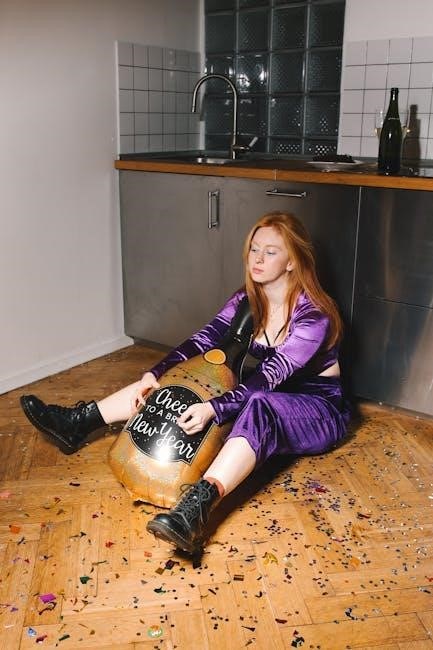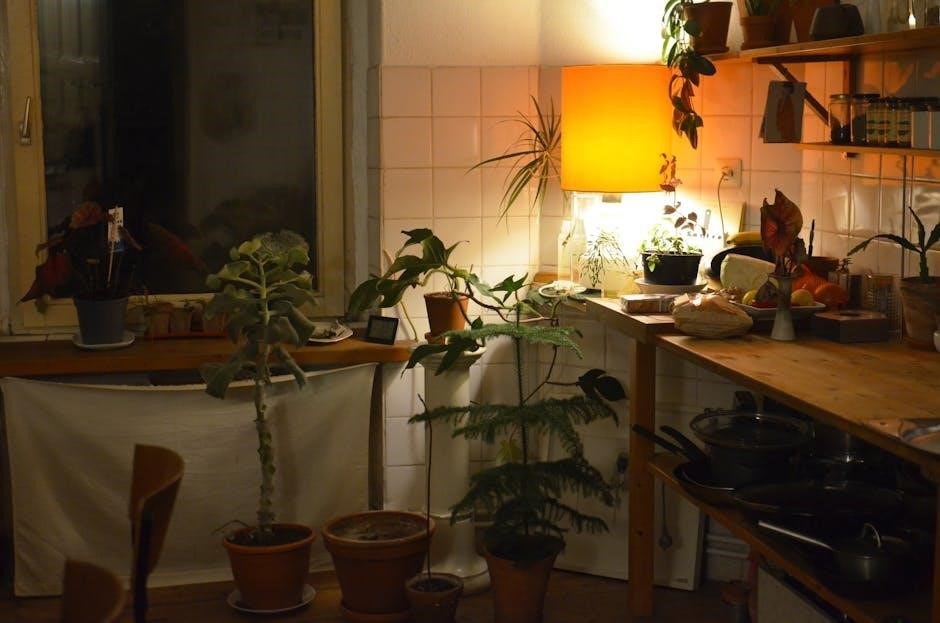“In the Night Kitchen” is a captivating children’s book by Maurice Sendak, first published in 1970. It follows Mickey, a young boy, as he falls into a surreal world.
The story explores themes of childhood imagination, identity, and the boundaries between reality and fantasy, featuring Sendak’s signature vivid illustrations and poetic prose.
Winner of the Caldecott Medal, the book has been praised for its unique storytelling and artistic brilliance, though it has also sparked controversy over its content.
It remains a timeless classic, cherished for its ability to evoke wonder and curiosity in readers of all ages, while addressing deeper existential questions.
1.1 Background and Publication History

“In the Night Kitchen” was first published in 1970 by Harper & Row, marking the third book in Maurice Sendak’s iconic trilogy, following Where the Wild Things Are and In the Night Kitchen.
The story was groundbreaking for its time, blending surreal imagery with a dreamlike narrative that explored themes of identity and imagination. Sendak’s distinctive illustrations and poetic prose captivated readers, earning it the Caldecott Medal in 1971.
Despite its acclaim, the book faced controversy due to its depiction of a nude child and fantastical elements, leading to bans in some schools and libraries. Nonetheless, it remains a celebrated work in children’s literature, praised for its originality and emotional depth.
1.2 Overview of the Storyline
“In the Night Kitchen” follows Mickey, a young boy who falls into a surreal world known as the Night Kitchen. The story begins with Mickey drifting off to sleep, only to find himself in a strange, dreamlike environment filled with giant bakers and abstract landscapes. The bakers, who resemble a cross between chefs and industrial workers, are startled by Mickey’s presence and attempt to bake him into a cake; Mickey cleverly outsmarts them, asserting his identity and ultimately escaping the Night Kitchen. The tale explores themes of identity, resilience, and the power of imagination, blending fantasy with subtle psychological depth.
1.3 Themes and Symbolism
“In the Night Kitchen” delves into themes of childhood imagination, identity, and the struggle between order and chaos. Mickey’s journey symbolizes a rite of passage, navigating a surreal world where he confronts his own existence. The night kitchen itself represents a space of creativity and transformation, where boundaries blur. The imagery of baking and dough evokes notions of creation and destruction, while the contrast between light and darkness reflects inner conflicts. The story also explores the idea of control, as Mickey asserts his agency in a world governed by mysterious forces. These themes, layered with symbolic elements, make the book a profound exploration of growth and self-discovery.
The Origin and Usage of “Night” in Time Expressions
The term “night” originates from ancient timekeeping, often linked to the moon’s visibility. Historically, “at night” indicated a specific point, while “in the night” referred to the entire period.
2.1 Historical Development of “Night” as a Time Indicator
The term “night” has evolved as a time indicator, originally referring to the dark period between sunset and sunrise. Historically, “night” was used to denote a general time span rather than a specific point. Over time, expressions like “at night” emerged to specify events occurring during this period, while “in the night” emphasized the duration. For example, “Friday night at midnight” distinguishes a precise moment, whereas “midnight in the night” highlights the broader timeframe. This shift reflects how “night” transitioned from a vague to a more precise temporal marker, influenced by linguistic and cultural needs.
2.2 Prepositions in Time Expressions: “In” vs. “At” Night
The use of prepositions with “night” varies depending on context. “At night” typically refers to a specific point or period, such as midnight or Friday night. For example, “The event starts at night” specifies the time without ambiguity.
In contrast, “in the night” often describes a general period, like in the dead of night, emphasizing the darkness or secrecy. It can also refer to events occurring during nighttime, such as “Someone stole my phone in the night.”
Both prepositions are correct, but their usage depends on whether the focus is on a specific moment (at) or a broader timeframe (in). This distinction helps clarify meaning in spoken and written English.
2.3 Cultural and Linguistic Variations in Night-Related Phrases
Cultural and linguistic variations significantly influence how night-related phrases are expressed. In English, “night” is often paired with prepositions like “in” or “at,” but usage can differ across regions. For instance, “in the night” may emphasize the duration, while “at night” refers to a specific time. Other languages, such as Spanish (“de noche”) or French (“pendant la nuit”), use distinct structures. Additionally, expressions like “night-time” and “nighttime” vary in acceptance, with “nighttime” being more common in American English. These variations reflect cultural perceptions of time and darkness, shaping how people communicate about nocturnal activities globally.

The Spoken and Written Use of “Night”
The spoken use of “night” often varies between informal and formal contexts, with phrases like “good night” being common in speech. Written forms maintain clarity and precision.
3.1 Informal vs. Formal Usage of “Night” in Speech
In informal speech, “night” is often used casually, such as in greetings like “good night” or “have a good night.” This usage is common in everyday conversations.

Formal speech may employ more structured expressions, like “good evening” or “good night,” depending on the context and relationship between speakers.

The choice between informal and formal language depends on the setting, such as personal interactions versus professional environments.
Informal usage is prevalent in relaxed settings, while formal usage is reserved for more polished or official communication.
This distinction reflects how “night” adapts to different social contexts, maintaining clarity and appropriateness in various situations.
3.2 The Proper Written Equivalent of “Night” in Formal Contexts
In formal writing, “night” is often used in expressions like “at night” or “during the night” to denote specific times. For instance, “The meeting will take place at night” is a formal way to express timing. In contrast, informal speech might use “tonight” or “good night” casually. The written form maintains clarity and precision, avoiding ambiguity. For example, “The event occurs at night” is more formal than “The event happens tonight.” This distinction ensures that formal contexts retain a level of sophistication and grammatical correctness, making “night” a versatile yet precise term in written language.
3.3 Regional Differences in Night-Related Expressions
Regional variations in night-related expressions reflect cultural and linguistic diversity. In British English, phrases like “night-time” or “tonight” are common, while American English often uses “nighttime” or “tonight” interchangeably. Some regions use “of a night” to describe evening routines, while others prefer “at night.” For example, “He works of a night” is typical in the UK, whereas “He works at night” is more common in the U.S. Additionally, expressions like “y’all come back now” in the southern U.S. or “cheerio” in British contexts highlight regional flair. These differences enrich language, showing how night is perceived and expressed uniquely across cultures.

The Distinction Between “Evening” and “Night”
Evening typically begins after sunset, while night starts around 10-11 PM. Cultural perceptions vary, but evening transitions into night as daylight fades completely, with some overlap in usage.
4.1 When Does Evening Transition into Night?
The transition from evening to night is often ambiguous, varying by culture and context. Generally, evening begins around 5-8 PM, while night starts after 9 PM. However, perceptions differ.
- Culturally, evening is often associated with winding down, while night signifies rest or late activities.
- Some languages mark the shift with specific terms, reflecting societal norms about daylight and darkness.
This fluid boundary highlights how time expressions are influenced by both biology and culture, shaping our understanding of day and night cycles.
4.2 Overlapping Periods and Their Usage in Language
The transition from evening to night is often fluid, with no strict dividing line, leading to overlapping periods in both timekeeping and language. Culturally, evening may extend into early night, while night can blend into late evening, depending on context. For instance, “tonight” often refers to the current evening and night, while “last night” specifies the previous night. This flexibility in terminology reflects the gradual nature of daylight transitioning to darkness, allowing for varied expressions to suit different situational needs and cultural perceptions of time.
4.3 Cultural Perceptions of Evening and Night
Cultural perceptions of evening and night vary widely, influencing how these periods are understood and expressed. In many societies, evening is associated with relaxation and family time, while night is linked to rest or spirituality. Some cultures mark the transition with rituals, such as lighting lamps or praying. In contrast, modern urban life often blurs these distinctions, with evening extending into night through social activities. These perceptions shape language, as seen in phrases like “good evening” or “good night,” reflecting societal norms. Such cultural nuances highlight the deep symbolic meaning attached to these time periods across different communities and traditions.
Morning, Night, and Timekeeping
5.1 The Concept of Morning and Its Relation to Night
Morning signifies the start of the day after waking, while night begins upon sleeping. This distinction shapes how time is perceived and expressed in daily life.
5.2 Timekeeping at Night: AM/PM Designations
The 12-hour clock uses AM (before noon) and PM (after noon) to denote times, helping distinguish morning from night in formal schedules and communications.
5.3 Practical Examples of Time Expression at Night
Phrases like “1 o’clock in the morning” or “1 o’clock at night” clarify time, with the former referring to post-midnight and the latter to late evening hours.
Morning signifies the beginning of a new day, contrasting with night’s conclusion. The transition from night to morning marks renewal, often symbolizing fresh starts and opportunities. While night is associated with rest, morning represents activity and awakening. The relationship between the two is cyclical, with morning following night as part of the 24-hour clock. In timekeeping, morning is typically defined as the period after midnight, while night begins after sunset. This duality reflects the natural balance between light and darkness, influencing human routines and cultural perceptions of time. The interplay between morning and night underscores the continuous passage of time.
In timekeeping, the night is divided using the 12-hour clock with AM/PM designations. Midnight marks the start of the AM period, while noon begins PM. Times like 12:00 AM represent midnight, and 12:00 PM is noon. This system helps distinguish between morning and evening hours. For example, 1:00 AM refers to the early morning, while 1:00 PM denotes the afternoon. This dual designation clarifies time expressions, especially at night, ensuring precision in communication. The AM/PM system is widely used in both spoken and written contexts to avoid ambiguity in timekeeping.

Common expressions for time at night include “midnight,” “1 AM,” or “12:30 AT NIGHT.” For example, “The movie starts at midnight” or “We arrived at 2 AM;”
- “I’ll meet you at 9 PM tonight;”
- “The concert begins at midnight.”
- “She usually calls at around 10 PM.”
These phrases clearly indicate specific times during the night, helping to avoid confusion in communication.
Expressions Involving Nighttime Activities
Phrases like “at night” and “in the night” describe activities during darkness, while “by night” contrasts nocturnal actions with daytime routines, highlighting unusual behaviors.
6.1 Using “By Night” to Describe Nocturnal Activities
The phrase “by night” is often used to describe activities that occur during the nighttime, contrasting with daytime routines. For instance, “She works by day and writes by night” highlights the division between diurnal and nocturnal pursuits. This expression emphasizes the time of day when actions take place, creating a clear distinction between light and dark periods; In “In the Night Kitchen,” Mickey’s adventures unfold “in the night,” showcasing how “by night” can evoke a sense of mystery and uniqueness in describing nocturnal events. This usage is particularly common in literature to set a specific tone or atmosphere.
6.2 Contrasting Daytime and Nighttime Actions
In “In the Night Kitchen”, the contrast between daytime and nighttime actions is central to the narrative. Mickey’s journey begins in the safety of daylight, where routine and order prevail, but transitions into the mysterious night, where fantasy and transformation unfold.
The bakers, who operate exclusively at night, symbolize the magic and secrecy of nocturnal activities, contrasting with the mundane daytime world. This duality highlights the book’s exploration of identity and imagination, as Mickey navigates both realms, blending the ordinary with the extraordinary.
Sendak’s vivid illustrations and poetic text emphasize this contrast, creating a visual and thematic divide that underscores the unique qualities of night and its role in shaping human experience.
6.3 Unusual or Unexpected Nighttime Behaviors
In In the Night Kitchen, Mickey’s journey through the night kitchen represents a departure from typical nighttime routines. His surreal encounters with strange creatures and machinery highlight unconventional behaviors, blending fantasy and reality. The story explores how nighttime can be a time for unexpected adventures, challenging the notion of rest and sleep. Mickey’s active participation in the night kitchen’s chaotic world contrasts sharply with the passive nature of sleep, showcasing how nighttime can be a realm of exploration and transformation. This theme invites readers to rethink their perceptions of what happens in the night.

Linguistic Variations and Acceptance
The term “night-time” and “nighttime” are both accepted, with regional preferences. British English often uses “night-time,” while American English favors “nighttime” as a single word.

Cultural and linguistic variations influence how “night” is expressed, with some dialects using phrases like “of a night” or “at night” for specific contexts.
Standard English typically accepts both “night-time” and “nighttime,” though style guides may prefer one form over the other for consistency in writing.
7.1 The Use of “Night-Time” vs. “Nighttime”
The terms “night-time” and “nighttime” are often debated in English usage. Both refer to the period between evening and morning, but their spelling varies regionally. In British English, “night-time” is commonly used, often with a hyphen, while American English prefers “nighttime” as a single word. Both forms are correct and accepted in standard English, though style guides may lean toward one or the other. For example, night-time activities and nighttime routines are equally valid. The choice ultimately depends on regional preference or stylistic convention.
7.2 British vs. American English Usage
In British English, terms like night-time are often hyphenated, whereas American English prefers nighttime as a single word. This variation reflects broader spelling differences between the two dialects.
Additionally, expressions involving night may differ in preposition usage, with British speakers sometimes favoring in the night for events occurring during darkness, while Americans often use at night.
Such distinctions highlight the subtle linguistic variations between British and American English, even in common time-related phrases involving night.
7.3 Standard English Expressions Involving Time and Night
In standard English, expressions involving time and night often follow specific conventions. Phrases like “at night” and “in the night” are used differently, with “at night” typically referring to the specific time of darkness, while “in the night” describes the night as a period. For example, “midnight” is often paired with “at”, as in “at midnight.” Expressions like “tonight” and “last night” are widely accepted and commonly used. These distinctions ensure clarity in communication, making time expressions involving night both precise and universally understood in English-speaking contexts.
“In the Night Kitchen” is a celebrated tale exploring imagination, identity, and reality. Its acclaim stems from its vivid storytelling and artistic depth, sparking meaningful conversations about childhood and existence.
8.1 Summary of Key Points
“In the Night Kitchen” by Maurice Sendak is a thought-provoking children’s book published in 1970, exploring themes of identity, imagination, and the surreal. The story follows Mickey, a young boy, as he navigates a fantastical world, blending reality and fantasy. Winner of the Caldecott Medal, the book is celebrated for its vivid illustrations and poetic prose, though it has also faced controversy due to its content. Despite this, it remains a beloved classic, cherished for its ability to evoke wonder and curiosity while addressing deeper existential questions, making it a timeless piece of children’s literature.
8.2 Final Thoughts on the Usage of “Night” in Language
The term “night” holds a unique and significant place in language, offering rich and diverse expressions for time and human experience. Its versatility is evident in both spoken and written forms, adapting effortlessly to informal and formal contexts alike. Cultural variations further enrich its usage, with phrases like “in the night” and “at night” reflecting subtle yet important differences in expression and meaning. The evolution of “night” in language underscores its dynamic and adaptive nature, continually adjusting to changing communication needs while maintaining its core significance in human expression. As seen in works like “In the Night Kitchen,” “night” continues to inspire creativity, evoke emotions, and convey profound meanings in storytelling, poetry, and everyday conversation, making it an enduring and essential element of our linguistic landscape.